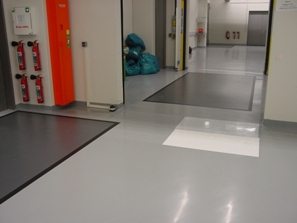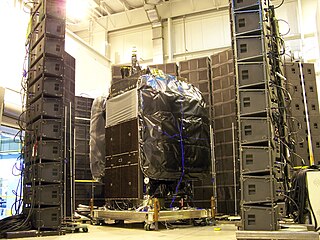
A cleanroom or clean room is an engineered space that maintains a very low concentration of airborne particulates. It is well isolated, well controlled from contamination, and actively cleansed. Such rooms are commonly needed for scientific research and in industrial production for all nanoscale processes, such as semiconductor manufacturing. A cleanroom is designed to keep everything from dust to airborne organisms or vaporised particles away from it, and so from whatever material is being handled inside it.

HEPA filter, also known as high-efficiency particulate absorbing filter and high-efficiency particulate arrestance filter, is an efficiency standard of air filters.
A United States defense standard, often called a military standard, "MIL-STD", "MIL-SPEC", or (informally) "MilSpecs", is used to help achieve standardization objectives by the U.S. Department of Defense.
Environmental stress screening (ESS) refers to the process of exposing a newly manufactured or repaired product or component to stresses such as thermal cycling and vibration in order to force latent defects to manifest themselves by permanent or catastrophic failure during the screening process. The surviving population, upon completion of screening, can be assumed to have a higher reliability than a similar unscreened population.
Ultra-low particulate air (ULPA) is a type of air filter. A ULPA filter can remove from the air at least 99.999% of dust, pollen, mold, bacteria and any airborne particles with a minimum particle penetration size of 120 nanometres. A ULPA filter can remove—to a large extent but not 100%—oil smoke, tobacco smoke, rosin smoke, smog, and insecticide dust. It can also remove carbon black to some extent. Some fan filter units incorporate ULPA filters. The EN 1822 and ISO 29463 standards may be used to rate ULPA filters.

MIL-STD-810, U.S. Department of Defense Test Method Standard, Environmental Engineering Considerations and Laboratory Tests, is a United States Military Standard that emphasizes tailoring an equipment's environmental design and test limits to the conditions that it will experience throughout its service life, and establishing chamber test methods that replicate the effects of environments on the equipment rather than imitating the environments themselves. Although prepared specifically for U.S. military applications, the standard is often applied for commercial products as well.
A rugged computer or ruggedized computer is a computer specifically designed to operate reliably in harsh usage environments and conditions, such as strong vibrations, extreme temperatures and wet or dusty conditions. They are designed from inception for the type of rough use typified by these conditions, not just in the external housing but in the internal components and cooling arrangements as well.
A particle counter is used for monitoring and diagnosing particle contamination within specific clean media, including air, water and chemicals. Particle counters are used in a variety of applications in support of clean manufacturing practices, industries include: electronic components and assemblies, pharmaceutical drug products and medical devices, and industrial technologies such as oil and gas.

Air showers are specialized enclosed antechambers which are incorporated as entryways of cleanrooms and other controlled environments to reduce particle contamination. Air showers utilize high-pressure, HEPA- or ULPA-filtered air to remove dust, fibrous lint and other contaminants from personnel or object surfaces. The forceful "cleansing" of surfaces before entering clean environments reduces the number of airborne particulates introduced.
FED-STD-209 EAirborne Particulate Cleanliness Classes in Cleanrooms and Cleanzones was a federal standard concerning classification of air cleanliness, intended for use in environments like cleanrooms. The standard based its classifications on the measurement of airborne particles.
ISO 14644 Standards were first formed from the US Federal Standard 209E Airborne Particulate Cleanliness Classes in Cleanrooms and Clean Zones. The need for a single standard for cleanroom classification and testing was long felt. After ANSI and IEST petitioned to ISO for new standards, the first document of ISO 14644 was published in 1999, ISO 14644-1.
The ISO 14698 Standards features two International Standards on biocontamination control for cleanrooms. IEST, the Secretariat and Administrator of ISO Technical Committee 209, helped develop this series of ISO 14698 Standards.

Contamination control is the generic term for all activities aiming to control the existence, growth and proliferation of contamination in certain areas. Contamination control may refer to the atmosphere as well as to surfaces, to particulate matter as well as to microbes and to contamination prevention as well as to decontamination.
Reliability of a semiconductor device is the ability of the device to perform its intended function during the life of the device in the field.

An environmental chamber, also called a climatic chamber or climate chamber, is an enclosure used to test the effects of specified environmental conditions on biological items, industrial products, materials, and electronic devices and components.

A biosafety cabinet (BSC)—also called a biological safety cabinet or microbiological safety cabinet—is an enclosed, ventilated laboratory workspace for safely working with materials contaminated with pathogens requiring a defined biosafety level. Several different types of BSC exist, differentiated by the degree of biocontainment they provide. BSCs first became commercially available in 1950.

Package testing or packaging testing involves the measurement of a characteristic or property involved with packaging. This includes packaging materials, packaging components, primary packages, shipping containers, and unit loads, as well as the associated processes.
Cleanroom suitability describes the suitability of a machine, operating utility, material, etc. for use in a cleanroom, where air cleanliness and other parameters are controlled by way of technical regulations in accordance with ISO 14644.

A fan filter unit (FFU) is a type of motorized air filtering equipment. It is used to supply purified air to cleanrooms, laboratories, medical facilities or microenvironments by removing harmful airborne particles from recirculating air. The units are installed within the system's ceiling or floor grid. Large cleanrooms require a proportionally large number of FFUs, which in some cases may range from several hundred to several thousand. Units often contain their own pre-filter, HEPA filter and internally controllable fan air distribution.

Direct-field acoustic testing, or DFAT, is a technique used for acoustic testing of aerospace structures by subjecting them to sound waves created by an array of acoustic drivers. The method uses electro-dynamic acoustic speakers, arranged around the test article to provide a uniform, well-controlled, direct sound field at the surface of the unit under test. The system employs high capability acoustic drivers, powerful audio amplifiers, a narrow-band multiple-input-multiple-output (MIMO) controller and precision laboratory microphones to produce an acoustic environment that can simulate a helicopter, aircraft, jet engine or launch vehicle sound pressure field. A high level system is capable of overall sound pressure levels in the 125–147 dB for more than one minute over a frequency range from 25 Hz to 10 kHz.








